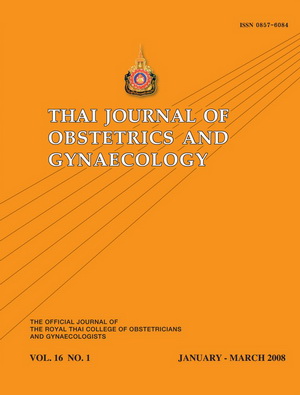Early versus Delayed Cord-Clamping in Term-Infants Born at Khon Kaen Regional Hospital
Main Article Content
Abstract
Objectives To compare the hematological status of early versus delayed cord clamping on hematocrit, hemoglobin and possible adverse outcomes at 48 hours after birth.
Study design A randomized, controlled trial.
Setting Department of Obstetrics and Gynecology, Khon Kaen Regional Hospital.
Material and methods 94 singleton term pregnancies were eligible for inclusion and randomly assigned to a group for either early cord clamping (ECC at the first 10 sec) or delayed cord clamping (DCC at 120 sec) after vaginal delivery. Infants’ hematological status (hematocrit, hemoglobin and total serum bilirubin) and clinicals were evaluated 48 hours after birth.
Results All 94 infants were enrolled into the study, 47 were randomized to receive ECC and 47 DCC. At baseline the groups had similar maternal demographic characteristics. At 48 hrs after delivery, the mean infant hematocrit was statistically significant higher in DCC group (56.2 and 49.6 percent, respectively). The proportion of anemic infants was statistically significant higher in the ECC (15.9 %) vs. the DCC (2.2 %) group. No statistically significant differences were found in the proportion of polycythemic infants, hyperbilirubinemia and the use of phototherapy between groups.
Conclusion DCC 2 minutes after vaginal delivery improved infant hematocrit and hemoglobin within a physiologic range and this intervention is simple, safe and should be implemented in a strategy to prevent early neonatal anemia.


